The Best Way To Deadhead Agapanthus Plants & Keep Them In Tip-Top Shape
We may receive a commission on purchases made from links.
The stately agapanthus, commonly known as an African lily, is a tall-growing plant that will transform a small garden or add timeless elegance to a large one. With its signature blue flowerheads that explode like fireworks from graceful, slim plant stalks emerging from neat clumps of glossy leaves, it's a must-have for gardens in USDA Hardiness Zones 8 to 11. Once the flowers fade in the late summer or fall, they make way for seedpods, which eventually dry out and can look tatty. Deadheading agapanthus plants in the correct way, which is cutting them at the base once the petals turn brown, will keep your plant healthy and your garden tidy.
But first, let's back up a bit. What is deadheading in the garden and is it a must? Deadheading is removing old flowers once they've faded, and it's often done to encourage the plant to produce more blooms. While deadheading your agapanthus won't cause profuse flowering, it can help the plant to develop an extra flower spike or two when the next flowering season comes around.
Deadheading isn't all you can do to keep your agapanthus in tip-top shape. They love regular watering, but will rot in soil that doesn't drain well. If you have an evergreen variety, check the leaves. Any that are turning yellow, brown, or looking damaged can be removed. Make sure you leave enough greenery for the plant to keep absorbing the sun and creating energy. Deciduous varieties that go dormant during the colder months can be left as they'll shed their leaves naturally in the fall.
The nitty-gritty of deadheading an agapanthus
Picking the right stage in the growth cycle will help an agapanthus thrive. The best time to clip off the flowers is when the petals turn brown and begin to drop off. If you leave it, the plant will use energy to develop seedpods and seeds, which may impact the next round of flowers. The process of deadheading an agapanthus is straightforward. Using Fiskars Pruning Scissors, cut each stem at the base of the plant, so that there's no stalk protruding from between the leaves. Cutting any higher will leave green stems waving in the breeze, which will look very strange.
One job you don't need to do after deadheading is fertilizing your agapanthus plants. Once they've flowered, they'll begin to slow down and get ready for winter. Fertilizer will encourage them to produce new leaves that won't survive the cold anyway, particularly those that go dormant. The best time to fertilize these plants is in spring or during the flowering phase, which can help them put on a spectacular show.
Follow these tips and your agapanthus should thrive and lure hummingbirds to your yard with bright blue flowers they can't resist. Keep in mind that they are poisonous and shouldn't be eaten by people or pets. They do, however, make excellent cut flowers and add glamor to any room they're displayed in. Who knows — you may be so tempted to use them all for inside display that deadheading won't ever be necessary!

